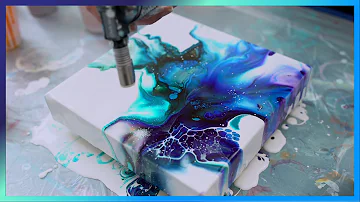Wie geht Fluid Painting?
How do you make a fluid painting?
A ratio of one part paint to three parts water should be enough to break down the acrylic binder so that the paint acts like watercolor. Also use fluid acrylics for glazing over another color, for creating drips (an eye dropper works well for this), for bleeding colors into each other, and for pouring.

What kind of paint do you use for fluid painting?
Fluid Acrylic Paints
Acrylic Inks and Soft Body, High Flow or Fluid Acrylic Paints are the perfect consistency for acrylic pour painting. Their consistency usually falls between milk (ink and high flow) and heavy cream (soft body and fluid).
How do you thin acrylic paint for pouring?
Adding up to 30 percent water to acrylic paint thins it but still allows it to coat a surface. Adding 60 percent or more water creates a watery paint application called a wash.
How do you describe fluid in art?
Fluid Art, which is also known as flow art, liquid art or acrylic paint pouring, is a fun and popular abstract painting technique that involves the use of fluid art mediums, such as free flowing acrylic, or very runny acrylics, powdered pigments or inks.
How do you mix acrylic paint for fluid painting?
Firstly, put some acrylic paint in a cup or container of your choice, and then pour in the same quantity or twice as much of the pouring medium, depending on the pouring medium used. Next, carefully combine all of the ingredients until they form a uniform acrylic mixture. It should have the consistency of liquid honey.
Can you just add water to acrylic paint for pouring?
In Acrylic Painting, you use water to dilute your acrylic paints. This works well, but is not recommended for Acrylic Pouring. Water not only changes the consistency, but also the pigment density and the adhesion of the paint to the painting surface. This means that the colors are lightened and no longer so bright.
What is the easiest paint pouring technique?
The Traditional Pour
If you break down pour painting to its most basic parts, it is essentially creating fluid colours with pouring medium and pouring them onto a canvas or board. The traditional pour is the most simple pouring technique of all and is straight forward for beginners.
How do you seal fluid art?
Varnish/enamel spray
Using a varnish or enamel spray is a very common way to seal all kinds of art work. They can be a very good option if you need your finish to be as affordable as possible, if you do not require an ultra high gloss finish or if you require a quick turn around.
How do you make fluid art shiny?
All you need to do is mix the gloss medium into the paint on the palette, and then paint as normal. The paint should dry to a glossy finish. To achieve even more gloss, apply a high gloss varnish once the painting is finished and the paint is dry.
Can you use olive oil for acrylic pouring?
ACRYLIC POURING AND MAKING CELLS WITH OLIVE OIL! – YouTube
Can you use rubbing alcohol to thin acrylic paint?
Can You Thin Acrylic Paint With Alcohol? You can thin acrylics with rubbing (isopropyl) alcohol, although you shouldn't use more than 20% alcohol in a mixture when thinning. Using too much alcohol can speed up the drying time of acrylic paint even more and will often result in uneven drying.
What are the 5 main characteristics of fluids?
All fluids, whether liquid or gas, have the same five properties: compressibility, pressure, buoyancy, viscosity, and surface tension. If a fluid is not compressible and it has zero viscosity it is considered an ideal fluid.
What are the 4 types of fluid?
Fluids are classified into four types depending on their flow, they are:
- Steady or unsteady.
- Compressible or incompressible.
- Viscous or non-viscous.
- Rotational or irrotational.
Do you wet the brush before using acrylic paint?
Acrylic Paint Instructions and Tips. You don't 'need' to start with a wet brush, but if you want your paint to glide smoothly then it's best to have the bristles wet.
Is Liquitex the same as Floetrol?
Sold in an easy-pour 1-quart bottle, Floetrol is a less costly alternative to Liquitex. It performs nearly as well, and possibly just as well, but is less archival.
Can you use house paint as a base for acrylic pouring?
So if you've got some leftover house paint that you love the colors of and you want some cheap, easy, super cool wall art, you can definitely achieve that with acrylic pouring.
How do you get bigger cells in acrylic pouring?
You will get lots of big cells by adding both floetrol and silicone oil to your acrylic paint mix. When you pour this mixture onto a surface the cells will very quickly reveal themselves.
Can I use Mod Podge on acrylic paint?
Can I use Mod Podge with paint? Absolutely – well mostly. You can use it with acrylic paint, and I highly recommend FolkArt Acrylic Paint as my brand of choice.
How do you price fluid art?
Charge by the square inch
To work out your price by the square inch, multiply the length by the width of your painting. For example, an 8 by 8 inch piece = 8 x 8 = 64 square inches. If you charge $1 per square inch, this would be $64 + the price of materials if you are adding that as well.
What is a dirty pour in fluid art?
Dirty pour – A technique where all colors are added to a cup or container at the same time and then poured together to create an acrylic pouring paint effect. A flip cup (see below) is also a form of dirty pour.
How do you keep fluid art from cracking?
How to prevent crazing in acrylic pours:
- 1) Use a good quality pouring medium. …
- 2) Avoid diluting your acrylic pouring mix with too much water. …
- 3) Work in a dry, room temperature environment. …
- 4) Apply any finishing varnishes only after your artwork has completely dried.
Can you use baby oil in paint pouring?
Before starting a paint pour, one must have the correct supplies. Some people use Elmer's Glue and other oils that they prefer or have found to work for them, i.e. baby oil or even WD-40.
Can you use dish soap for acrylic pour?
Acrylic Pour with Dish Soap – JAW-DROPPING Chameleon Cells …
What does baking soda do to acrylic paint?
So when you add baking soda to your paint it doesn't react with the paint in any way. It just adds texture, the grains of baking soda in the paint create the texture. Baking powder however reacts with the paint and changes it. As you'll see in pictures below the paint bubbles up, making it thicker.
What happens when you add vinegar to acrylic paint?
As vinegar is an acid, it is the absolute opposite of where the acrylic system likes to be and adding even a small amount will likely cause it to react negatively, and we would not recommend it. Although it is a good lesson in acrylic polymer chemistry!"


